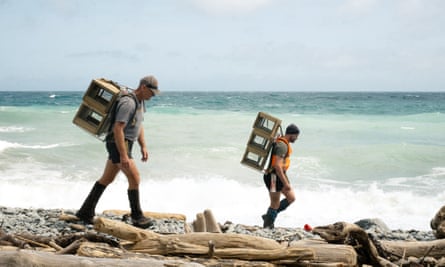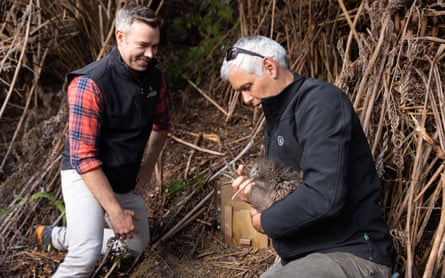‘Inherent in our identity’: Kiwi brought back to the wilderness of Wellington.wildlife
aOn the windswept ridges of Wellington’s south coast, above the rolling sea and in the shadow of roaring wind turbines, 11 kiwis (New Zealand’s prized national bird) are home for the first time in generations. I’m here.
The unique flightless bird has been busy for a week after arriving. Each of them emerged from their temporary artificial dwellings and began digging burrows in the hillsides with their strong claws. Soon they line their burrows with foliage, soft moss, and feathers, ready for giant alabaster-like eggs.
The kiwis, which will be closely monitored to make sure they settle into their new habitats, are the first cohort of 250 to be introduced into the wild around the capital over the next six years. Restoration of native wild birds.

It’s difficult to know exactly when the kiwi disappeared from the city, but some conservationists believe it has been gone for over 100 years. An estimated 12 million kiwis once roamed the country, but introduction of predators and habitat loss have pushed their numbers to a worrying low, with the latest estimates that he It has reached 68,000. Conservation efforts are slowly starting to increase the number of kiwis.
The arrival of the kiwi in Wellington marked the beginning of years of hard work by conservationists, establishing the country’s largest and most intensive stoat-hunting network, and importantly, attracting farmers not usually seen as conservationists. It represents enthusiastic buy-in from the community, including , off-road 4WD enthusiasts, mountain bike enthusiasts.
For the man who spearheaded the project, the release of the birds was a particularly moving moment. “You know how people say they get goosebumps? I describe it as a kiwi bump,” he said in 2018, putting his film career aside. Capital Kiwi Project – A community conservation project dedicated to returning wild kiwi populations to the capital.
Four years later, the $4.5 million project predator free 2050 (National Pest Control Program) achieved its first major goal. On 19 November, a ceremony was held at Makara Primary School with the participation of 300 of his people from the Capital Kiwi Project, iwi (tribes), local communities, conservationists and landowners.

Photo: Josiah Watson
Rawiri Walsh, Iwi’s liaison and field specialist for the project, is also Mana Fetua (meaning his Iiwi, Taranaki Whanaui Ki Te Upoko O Te Ika) and has territorial claims in the wider Wellington region. . The ceremony felt like a celebration of life.
“Everyone thought they would always be here until the kiwi was gone, and the loss was severe,” says Walsh.
Gifted by the Ngāti Hinewai hapū (subspecies), the bird traveled over 400 km from the Otorohanga Kiwi House to the Makara community, about 25 minutes from Wellington city centre. Among the feathered groups is a mating pair – a turkey-sized matriarch called Anahera, about 44 years old, and her 36-year-old mistress, Nouveau.
“When Anahera came out, she had this enchanting power. You could feel the silence in the crowd. Most of those people had never seen a kiwi before.” .House.
keep chicks alive
Ward stands on the ridge line at Teraphiti station. This is he one of the oldest and largest sheep farms in the country. It points to extensive farmland in the foothills and regenerating old-growth forest that landowners have allowed to become kiwi habitat in the coming years. Beside him, a veteran kiwi and his handler, Peter Kirkman, are receiving pings on a satellite locator from a recently released kiwi tagged with a transmitter. Meanwhile, his kiwi tracking dog Shih is searching with her nose to the ground.
Ward outlines an area of approximately 23,000 hectares, about the size of New Zealand’s famous Abel Tasman National Park. Over the past four years, a team of volunteers and project staff have installed his 4,500 Oko traps throughout the landscape.

Although vulnerable to large predators such as dogs, kiwis have powerful fighting claws for attacking smaller pests, and the size and thickness of their eggs keep predators at bay. But kiwi chicks are completely vulnerable, especially to stoats.
Without control, stoats will eat up to 100 percent of the chicks in the area, says Ward. The trapping network has captured 1,000 stoats since its inception. This is enough to keep the kiwi population at a level where it can thrive.
Once the birds mate, a surveillance team led by Kirkman closely monitors the hatching of the chicks. “If you can show the Conservation Department that he can keep six out of 20 chicks for 10 months, that’s considered a success,” he says. “But I think we get more.”
Kiwis are very resilient birds, says Ward. With food, you can be home almost anywhere, from the beach to the scrublands to far above the snowy mountains. However, it is important that the community “takes care” to make its environment as comfortable and safe as possible.
That consideration, or community buy-in, was evident throughout the project, Ward says. The Wards held countless meetings in wool sheds, village halls and cafés, and were shouted out by everyone they approached, from landowners to iwis to schools. Yes’ I want to bring kiwis back to the capital.
“There has been an incredible community shift from assuming conservation is done by Conservation Rangers in Fiordland and elsewhere to what we do in our backyards,” Ward said. increase.
Ward says some of the most astonishing groups committed to the project are mountain bikers and 4WD driving clubs who monitor 240 traps along parts of the coastline.
“They’re stereotyped as petrolheads, but they’re actually some of our most passionate and dedicated trappers.”
“Humans and wild animals can coexist”
It is perhaps this broad acceptance from the people that makes Wellington one of the few capitals that can boast of successfully reversing biodiversity loss. Booming native bird populations.
Stephen Hartley, Director of the Center for Biodiversity and Restoration Ecology, Victoria University of Wellington, said: .
Hartley and his network of colleagues across the country compared the ecological conditions of New Zealand’s cities, developed a sense of community, and attempted to gain council buy-in for conservation.
“Wellington is pretty extreme in terms of having the highest levels of council and community involvement,” Hartley said, adding that more than 50 volunteer conservation groups are setting traps and planting trees throughout the city. Added. In a city of just over 200,000 people, this is no small feat.
He has attributed much of the local interest to a 30-year effort, leading to a positive feedback loop and making the bounty of abundant native bird life visible in the city.
The Kiwi Project, on the other hand, is important because it “shows potential for all kinds of green space.” Makara shrub farmlands won’t always be an obvious choice for kiwi habitat, he says.
That’s the Capital Kiwi Project’s ultimate hope, Ward adds.
“Our goal is for people to go to sleep at night to the sound of kiwis, to see footprints on golf courses and paths they walk with their families, and what makes it possible. To understand. A guardian to them.”
https://www.theguardian.com/environment/2022/nov/26/intrinsic-to-our-identity-kiwi-brought-back-to-wellingtons-wilds ‘Inherent in our identity’: Kiwi brought back to the wilderness of Wellington.wildlife
